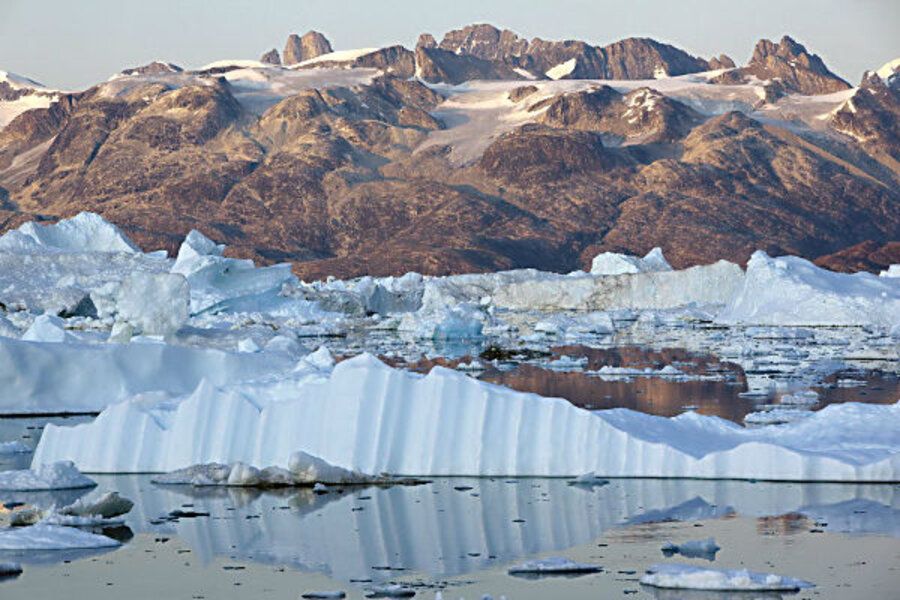Greenland's ice sheet: Climate change outlook gets a little more dire
Loading...
A shrinking Greenland ice sheet – losing mass because of global warming – may be closer to its point of no return than previously estimated.
If global average temperatures reach 1.6 degrees C (2.9 degrees F.) above preindustrial levels, the iconic ice sheet probably will tip toward irreversible loss, a new study finds.
With a rise already of 0.8 degrees C, global average temperatures already are halfway there.
In recent years, global climate talks have focused on trying to hold human-triggered warming to 2 degrees C by the end of the century. The study implies that even that goal would be too warm for winter snows to make up for summer melt for one of the planet's two major land-topping ice sheets.
The rate of ice loss expected for warming of 1.6 degrees is slow, occurring over 50,000 years, the researchers estimate. Higher climate-change temperatures would accelerate the process.
The ice sheet could lose 20 percent of its mass over the next 500 years from temperature increases associated with so-called business-as-usual greenhouse-gas emissions through century's end. In this case, the study indicates, the ice sheet could vanish in 2,000 years.
The loss of Greenland's ice sheet would raise global sea levels by an average of nearly 24 feet.
An earlier study, incorporated into the Intergovernmental Panel on Climate Change's 2007 global warming reports, suggested that the point of no return hovered around 3.1 degrees C. But even as those reports were released, researchers noted that more research, which was published too late to be included in the IPCC volumes, suggested that Greenland's ice sheet was responding to global warming faster than the reports indicated.
The loss rates that the new study implies are hardly rapid, acknowledges Alexander Robinson, a researcher at the Potsdam Institute for Climate Impact Research in Germany who is the study's lead author.
“However, compared to what has happened in our planet's history, it is fast,” he said in a prepared statement.
The team also acknowledges that pinning down the ice sheet's tipping point is of little immediate use for predicting the ice sheet's contribution to sea-level rise over the course of this century. The loss of such a vast surface reflecting sunlight into space will have a milleniums-long effect on global climate, the researchers say.
Along with Antarctica's ice sheets, Greenland's ice sheet has long been a source of information on Earth's climate history. But they also represent a source of concern for sea levels. Unlike the Arctic Ocean's sea ice, which already rides in the water and so makes little or no contribution to sea levels if it vanishes, the land-based ice sheets represent ice cubes added to a glass of water.
Last year, a team of scientists led by Edward Hanna, a researcher with the University of Sheffield in Britain, published a study using the latest updated weather records to track changes in the mass balance for Greenland's ice sheet from 1870 to 2010. The study shows the ice sheet gaining volume between 1870 and the mid-1920s. Since then, the ice sheet has been losing mass, albeit with brief upticks along the way. The results appeared in the Journal of Geophysical Research.
During much of the past decade, the ice sheet lost mass at a rate of between 191 billion and 240 billion tons a year, according to another study, based on ICESat satellite data. This result appeared last year in the journal The Cryosphere.
In an e-mail exchange, Dr. Robinson notes that with a business-as-usual warming of about 8 degrees C, Greenland's ice sheet would contribute about 30 centimeters a century to sea-level rise, or 1.5 meters over 500 years.
The study represents an advance over previous efforts, the team holds, because it takes two new factors into account: changes in ice-sheet altitude and the increase in heat-trapping land exposed by a shrinking ice sheet. As the sheet loses mass, it loses altitude – a key factor in maintaining cold temperatures on the sheet's surface, which ranges from 2,000 to 3,000 meters thick.
The researchers worked these factors into computer simulations of the ice sheet's behavior under a changing climate, using regional temperatures that could be expected for various levels of global warming.
The results suggest that under the right conditions, the ice sheet could stabilize, but cover a smaller area than it does today – consistent at least in kind, if not magnitude, with results other groups have gotten.
The results represent “a nice contribution” to efforts to plot the ice sheet's future, says Richard Alley, a glaciologist at Pennsylvania State University in State College, Pa., in an e-mail exchange.
But physics may be conspiring to further accelerate the process, he adds.
He and colleague Byron Parizek have pointed to meltwater on the ice sheet's surface as a source of lubricants that can speed the flow of ice to the sea. The center of the ice sheet is frozen to bedrock underneath it, significantly slowing the ice's spread. Such spreading lowers the ice sheet's altitude. Yet water in meltwater lakes in summer “can break through the ice to the bed in mere minutes,” Dr. Alley writes. Large volumes of meltwater would raise temperatures at the bed above the ice's melting point, speeding the ice's flow.
If this process migrates inland as the climate warms, it could further accelerate the ice loss, he says.
“I don't think we know enough to really assess this possibility yet,” he adds.
The new temperature-sensitivity study's results appear in the current issue of the journal Nature Climate Change.







